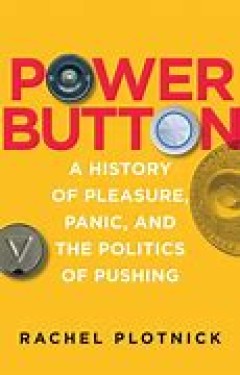Filter by

Power Button: A History of Pleasure, Panic, and the Politics of Pushing
Push a button and turn on the television; tap a button and get a ride; click a button and "like" something. The touch of a finger can set an appliance, a car, or a system in motion, even if the user doesn't understand the underlying mechanisms or algorithms. How did buttons become so ubiquitous? Why do people love them, loathe them, and fear them? In Power Button, Rachel Plotnick traces the ori…
- Edition
- -
- ISBN/ISSN
- 9780262347501
- Collation
- 1 online resource
- Series Title
- -
- Call Number
- -

Designing publics
Contemporary computing technologies have thoroughly embedded themselves in every aspect of modern life -- conducting commerce, maintaining and extending our networks of friends, and mobilizing political movements all occur through a growing collection of devices and services designed to keep and hold our attention. Yet what happens when our attention needs to be more local, collective, and focu…
- Edition
- -
- ISBN/ISSN
- 9780262337083
- Collation
- 1 online resource (xv, 151 pages).
- Series Title
- -
- Call Number
- -

Enabling Horizontal Collaboration Through Continuous Relational Learning
Now that supply chain operations are facing new challenges due to the necessity of reducing costs and CO2 emissions, companies are increasingly leveraging cooperation from companies from other supply chains as a source of competitive advantage. Horizontal Collaboration has been proved an efficient tool for cutting logistic costs up to 49%. Zaragoza Logistics Center, member of the MIT-Scale N…
- Edition
- 1
- ISBN/ISSN
- 978-3-319-08093-2
- Collation
- 1 b/w illustrations, 17 illustrations in colour
- Series Title
- -
- Call Number
- -

Environmental Management the Supply Chain Perspective
In view of the increasing quest for environmental management in businesses, this book provides a good reference to firms to understand how they may manage their supply chains to improve business and environmental performance. The book consists of six chapters covering such topics as environmental management, environmental management practices with supply chain efforts, collaborative environment…
- Edition
- 1
- ISBN/ISSN
- 978-3-319-23681-0
- Collation
- XI, 140
- Series Title
- -
- Call Number
- -

Integrated Management Systems
Examining the challenges of integrated management, this book explores the importance and potential benefits of using an integrated approach as a cross-functional concept of management. It covers not only standardized management systems (e.g. International Organization for Standardization), but also models of self-assessment, as well as different types of integration. Furthermore, it demonstrate…
- Edition
- 1
- ISBN/ISSN
- 978-3-319-10027-2
- Collation
- IX, 194
- Series Title
- -
- Call Number
- 338.7 INT

Fulfilling the pledge :securing industrial democracy for American workers in …
"A review of labor law exploring the decline of union power and demonstrating how collective bargaining can continue to support worker power and improve economic outcomes for workers and communities despite macro shifts in the US economy over the past 40 years"--OCLC-licensed vendor bibliographic record.
- Edition
- -
- ISBN/ISSN
- 9780262377348
- Collation
- 1 online resource
- Series Title
- -
- Call Number
- -

Inside the competitor's mindset :how to predict their next move and position …
"Practical guidance for business leaders to learn what their competitors will do and why, so organizations are better prepared to meet competitive challenges"--OCLC-licensed vendor bibliographic record.
- Edition
- -
- ISBN/ISSN
- 9780262373647
- Collation
- 1 online resource.
- Series Title
- -
- Call Number
- -

Dare to invent the future :knowledge in the service of and through problem-so…
"Proposes a new conceptual platform and a new library against the colonial, postcolonial and modern/Eurocentric libraries by re-appropriating the work of key Black thinkers to rethink questions of invention, transformation, and innovation alongside those of knowledge cosmologies and epistemologies"--OCLC-licensed vendor bibliographic record.
- Edition
- -
- ISBN/ISSN
- 9780262376716
- Collation
- 1 online resource.
- Series Title
- -
- Call Number
- -

Behavioral insights
An accessible introduction to the behavioral insights approach, which applies evidence about human behavior to practical problems. Our behavior is strongly influenced by factors that lie outside our conscious awareness, although we tend to underestimate the power of this "automatic" side of our behavior. As a result, governments make ineffective policies, businesses create bad products, and ind…
- Edition
- -
- ISBN/ISSN
- 9780262360135
- Collation
- 1 online resource
- Series Title
- -
- Call Number
- -

Victor Papanek :designer for the real world
"A cultural geneaology of the influence of Victor Papanek on the world of transdisciplinary design"--OCLC-licensed vendor bibliographic record.
- Edition
- -
- ISBN/ISSN
- 0262361590
- Collation
- 1 online resource.
- Series Title
- -
- Call Number
- -
 Computer Science, Information & General Works
Computer Science, Information & General Works  Philosophy & Psychology
Philosophy & Psychology  Religion
Religion  Social Sciences
Social Sciences  Language
Language  Pure Science
Pure Science  Applied Sciences
Applied Sciences  Art & Recreation
Art & Recreation  Literature
Literature  History & Geography
History & Geography